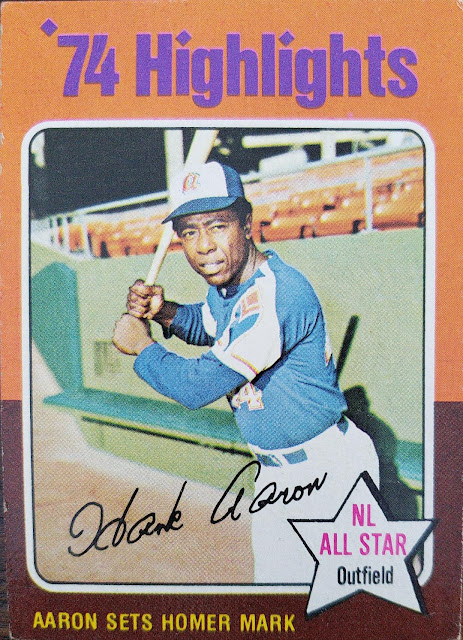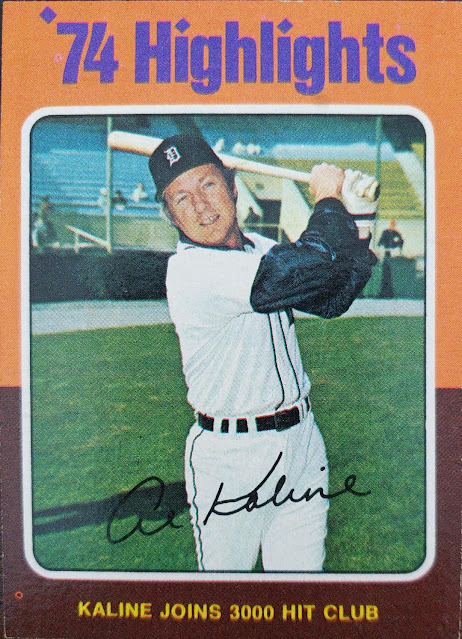Is this a new series? I think it might be.
I was attempting to hunt down a new angle for the "Joy of a Team Set" series a week or two ago, but I'm starting to feel like I've run out of ideas for that series. I'm not going to end it, I may have just hit a temporary snag, but I thought I'd go in a slightly different direction.
I've praised the common, ordinary subset many times on this blog and have devoted a full post to individual ones here and there. I've even written a magazine article focused on them.
Subsets seem like a fad of the past, with inserts taking over in the mid-to-late '90s. But the subset still appears periodically. However, I don't count a group of cards as subsets if they are not numbered consecutively in a set. That's the first rule of defining a subset. (Topps, start grouping your league leader cards together again, please).
Subsets have been part of main sets since the 1950s, probably longer. During the '50s and '60s, those subsets for Topps consisted chiefly of chronicling the previous year's World Series and league leaders and presenting an All-Star squad. A couple notable exceptions are the "Baseball Thrills" subsets for Topps in 1959 and 1961 and the Babe Ruth Story subset in 1962.
Today I'm starting this series with the first subset I ever knew. It's from the 1975 Topps set, of course.
I had no idea, when I was opening packs in 1975, that this was a first-of-its-kind set at the time, a new way of thinking for Topps. This was the first time in which Topps put together a themed subset that drew together various notable events from the previous season. But it didn't have anything to do with the postseason or focus on league leaders.
This subset kicked off a yearly tradition for Topps in which it reserved a few cards, consecutively numbered, that recognized feats from the previous year. The name for these would alternate, sometimes they'd be called "Highlights," sometimes "Record Breakers." Sometimes the subset would kick off a set, at card No. 1, sometimes it'd be buried somewhere within. The size of the subset would fluctuate, too. It could be 10 cards, it could be 4 cards.
This was such a standard part of the Topps set when I started collecting that I expected the cards every year. I enjoyed the look back, solidifying these milestones in cardboard. And Topps churned out the highlights/record breakers every year from 1975 through 1992.
After that, "looking back" become unfashionable and "looking forward" was all the rage. 1993 Topps replaced record breakers with an avalanche of "Coming Attraction" and "Draft Pick" cards, aside from the usual four-player "Top Prospects" cards. The "looking back" subset become a sporadic and then seldom-used element of card sets. (Meanwhile, the '93 Upper Deck set is practically an ode to the subset).
I am convinced that the "Highlights" subset came about in 1975 only because of one man:
Had Henry Aaron not established the career home run record in 1974, I wonder whether Highlights subsets would ever exist.
Topps had already created an Aaron-themed subset to kick off the 1974 set, so it was primed for special recognition the following year once he achieved the feat. But then other players blew up in 1974. Lou Brock broke Maury Wills' single-season stolen base record. Bob Gibson and Al Kaline each achieved 3,000 milestones. Things were happening! And Topps obtained inspiration.
Here is the back of the Aaron card in newspaper format, which will win me over every time. Topps had experience with this format and it's effective. It's a nicely simple presentation that gets you the basic facts, even if you were pulling this card more than a year after Aaron broke the record.
Lou Brock's card is possibly the worst in the series. We were used to staid shots of players as '70s collectors, but the fastest man in the game, and celebrating his fast feat, should not feature Brock sitting in the dugout.
Bob Gibson receives a nice shot outside of the fenced-in diamond, showing off his red glove. Gibson gets two cards in this set, thanks to this card. In fact, all of the players featured in this set receive multiple cards in '75 Topps, except for one.
This is the one. Al Kaline's only card in '75 Topps is the Highlights card. This is the card from the subset that I was most familiar with when I was collecting in '75. I only saw the Kaline and Ryan cards. I don't believe I owned either. Could be wrong there.
The majestic Nolan Ryan shot. Yeah, we knew this was a pretty cool card at the time. Topps spends a good portion of the back of the card writing about Ryan's 383-strikeout season in 1973, which remains the modern record.
My favorite card from this subset for obvious reasons and also the most interesting, thanks to Marshall refusing to pose for Topps. We have a mound meeting with Marshall and manager Walter Alston as well as Steve Yeager and Bill Russell. It makes you wonder what Topps could have done with photos at the time if its hand was forced.
The only horizontal card in the subset gets Ryan on a third card in the '75 Topps set, and also provides the only actual photo of Steve Busby in the set, since Topps got the wrong guy for Busby's own card.
This card seems a little forced as three no-hitters in a season wasn't exceptional -- there were four in 1973. However, both Busby and Ryan threw no-hitters for the second straight year, so that's something.
So that's seven cards and thanks to Topps presenting "Highlight/Record Breaker" subsets at the start of its set in both 1975 and 1976, that's how I thought it was going to be. Then Topps began its '77 Record Breaker set at card #231 and what is happening anymore?
Just to add a little color to the post, here are the players in the 1975 set that are mentioned on the backs of the Highlight cards:
The two other players mentioned on the back don't have cards in the '75 set, but it's Babe Ruth's birthday today so I can't go without showing a card of him.
Those are the two other guys mentioned.
And now you know my next topic for "Joy of a Subset."
If I don't forget about this series altogether.












Comments
I've never seen the horizontal Highlights card before. Aside from being a somewhat forced highlight, the design of the card feels undercooked too with square instead of rounded corners and putting the names in the white border.
Would you consider that Al Kaline HL his sunset card? I had a similar thought about Walter Payton and Dan Fouts in the '88 Topps Football set.
I'm not familiar with Mike Marshall's refusal to pose for Topps cards. He appeared on their cards, so he must have had some agreement with them -- it wasn't like a Maury Wills situation, right?
Anyway, the '74 season sure sounded like the right time to start highlighting major accomplishments - especially Hank Aaron.
B. 1982 Donruss Diamond Kings were the first subset cards I remember thinking were extra special. Maybe it's because I was a kid and I liked the drawings.
C. Didn't know about Marshall refusing to pose for Topps (or maybe I've heard about it before and forgot). But I'm kind of glad he did, because he has some really nice action shots on his Topps baseball cards.
Sure, that can be Kaline's sunset card. I don't really recognize those, but it makes sense.
Marshall didn't make himself available to Topps photographers for posed shots. I wrote about it in another magazine article. He signed a contract with Topps but didn't like Sy Berger's deal and eventually stopped agreeing to have his image used in Topps sets (that's why there are no cards of him after 1977 in Topps).
Nor did I know about mike Marshall and topps. Mike was from Michigan and known locally to be kind of a flake. Fascinating character but off the wall. I think he did have an early 1980s fleer while on the Mets. I do remember 1969 story where marvin Miller told players to refuse to pose for topps until they got a better deal, so topps had to find earlier photos.
Topps fb really had the problems with players opting out..Namath last card 1973, Swann 1977, earl Campbell only has cards from 1979.